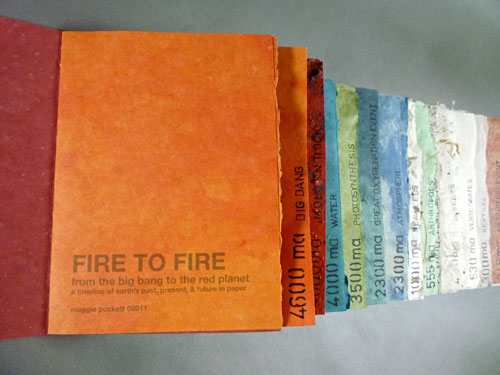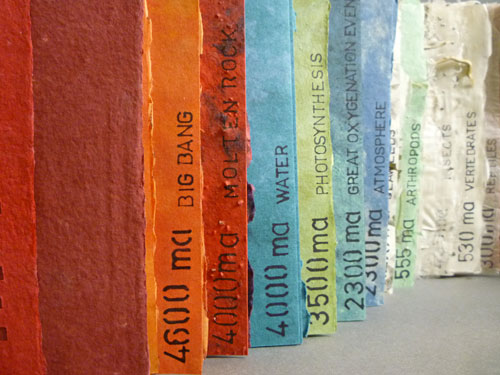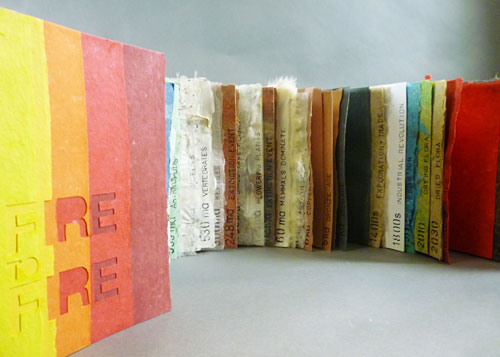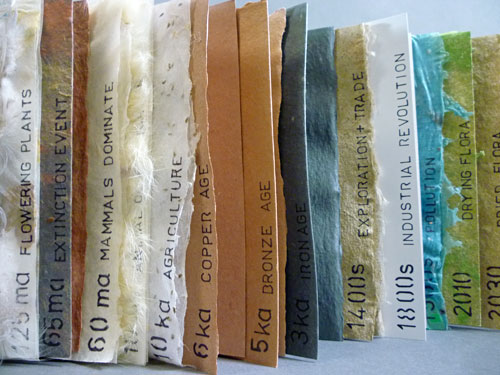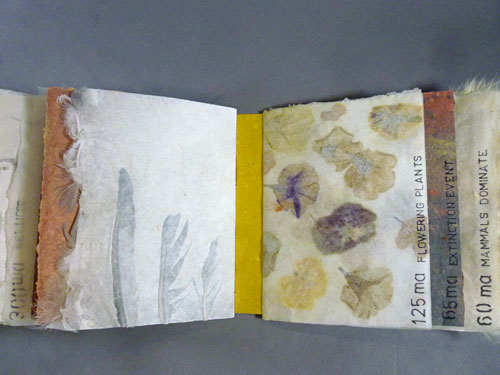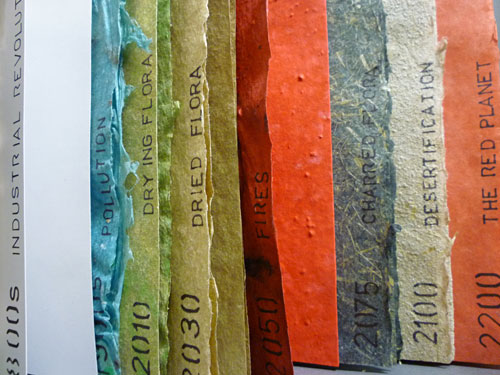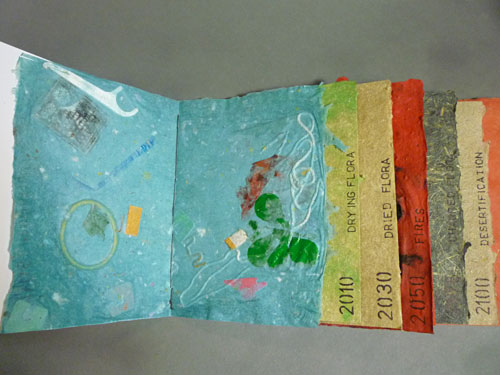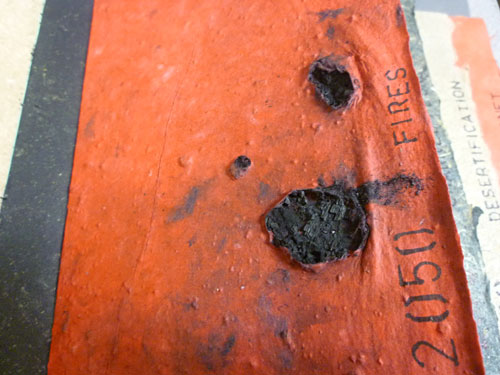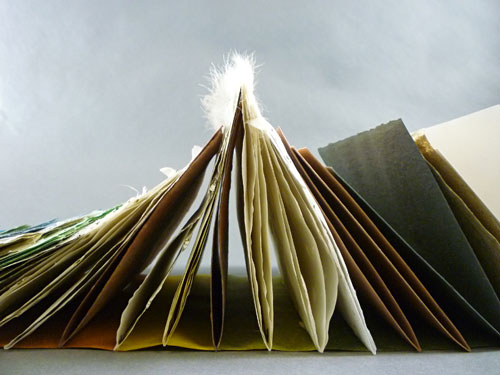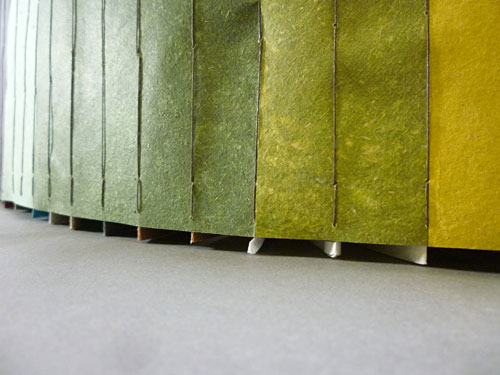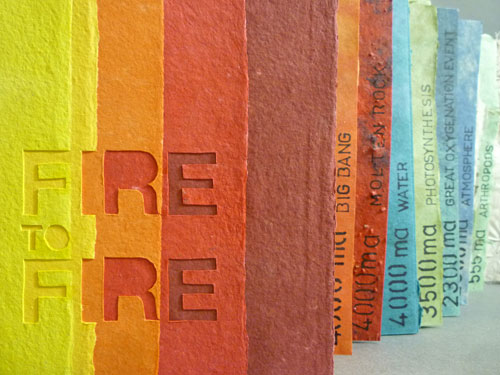
|
ARTIST'S BOOK
Fire to Fire: From the Big Bang to the Red Planet: A Timeline of the Earth’s Past, Present, and Future in Paper
2011
handmade paper (abaca, cotton, flax, linen, campfire charcoal, red and green marine algae, lobster shell, dried anchovies, roots, ants, shed snakeskin, feathers, pressed flowers, fur and leather, egg shells, vegetable seeds, ground cloves, litter, coarse desert sand, beach sand, pigment), commercial paper, thread, pva, ink
36.5 x 7.5 x 2 inches (flat)
Fire to Fire is a timeline of the Earth’s past, present, and future in 30 different types of handmade paper, and one sheet of machine-made paper. Utilizing specific fibers, inclusions, and pigments each signature of the book refers to a particular event in the history and possible future of our planet. The following is a list of each event and the materials used in the representative paper:
Table of Contents
1. 4600 million years ago (ma) The Big Bang
2. 4000 ma Molten Rock
3. 4000 ma Water
4. 3500 ma Photosynthesis
5. 2300 ma Great Oxygenation Event
6. 2300 ma Atmosphere
7. 1000 ma Seaweeds
8. 555 ma Arthropods
9. 430 ma Plants Root on Land
10. 430 ma Insects
11. 530 ma Vertebrates
12. 300 ma Reptiles
13. 248 ma Extinction Event
14. 150 ma Birds take flight
15. 125 ma Flowering Plants
16. 65 ma Extinction Event
17. 60 ma Mammals Dominate
18. 10 thousand years ago (ka) Animal Domestication
19. 10 ka Agriculture
20. 6 ka Copper Age
21. 5 ka Bronze Age
22. 3 ka Iron Age
23. 1400s Exploration + Trade
24. 1750-1800s Industrial Revolution
25. 1900s Pollution
26. 2000s Drying Flora
27. 2025 Dried Flora
28. 2050 Fires
29. 2075 Charred Flora
30. 2100 Desertification
31. 2200 The Red Planet
Each signature of the book is a different kind of paper, individually created with various fibers and inclusions representing the corresponding event. The first page of each signature is labeled, as if a specimen, with the event and date. A large variety of materials were used to make the paper: abaca, cotton, flax, linen, campfire charcoal, red and green marine algae, lobster shell, dried anchovies, roots, ants, shed snakeskin, feathers, pressed flowers, fur and leather, egg shells, vegetable seeds, ground cloves, litter, coarse desert sand, beach sand, and pigment. Much of the materials were found or repurposed, and collected throughout Southern California and Chicago. Each signature is bound according to a long piece of paper, which is composed of color-coded segments indicating geological epochs (Hadean, Archaean, Proterozoic, Paleozoic, Mesozoic, Cenozoic, Holocene, Anthropocene, and Future).
Fire to Fire is a rather short and pessimistic journey through the past, present and future of the planet. The events chosen are in no way exhaustive; a future version of this book would ideally explode this concept, translating as many events as possible into paper. Additionally, making the book more to scale would be conceptually advantageous; the audience would more easily understand how little time humans have been present in the life of the Earth, and how quickly we have screwed things up. Regarding the future parts of the book, my pessimism is apparent in the relatively little time we have before the Earth is a red planet, devoid of life like Mars. The pessimism in this book is counteracted with the optimism of Thaw and to some degree F.U.C.T. and Handkerchief for the Apocalypse.
The use of one sheet of machine-made, commercially available, photo-quality paper is charged with meaning. Many artists use machine-made paper by default, its use rarely considered integral to the artwork’s meaning. In Fire to Fire the slick, bright white sheet labeled “Industrial Revolution” sticks out like a sore thumb. Here, among sensuous colors, textures, and smells, this ascetic paper pales in comparison to its handmade counterparts. Its lifelessness is underscored and its presence finally perceived as a conceptual gesture. In his essay “The Revival of Handicraft”, William Morris states “that production by machinery necessarily results in utilitarian ugliness in everything which the labour of man deals with, and that this is a serious evil and a degradation of human life.” Fire to Fire exploits this utilitarian ugliness to make a powerful statement about industrial methods of production and their relationship to our environment.
Fire to Fire’s structure is a unique variation on traditional binding methods and codex forms, but obfuscates its “bookness” as it encroaches upon the territory of sculpture. The book can lay flat and straight, or stand on its tail, curving into an arc while supported by its slightly opened signatures. When flat, the turn of an interior page activates the turning of its immediate neighbor, which in turn activates the next signature, and the next. This action is a simple mimicry of complex causality in naturally occurring and manmade events.
Acquired by Savannah College of Art & Design, AVA Library Artist's Book Room, Atlanta, GA.
|












